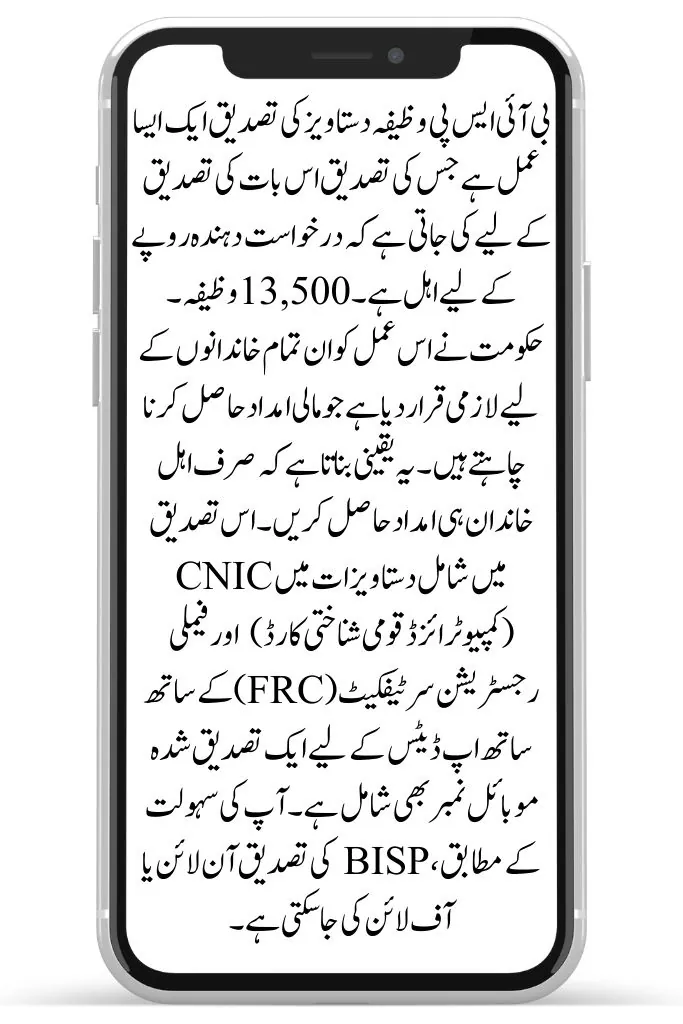The Benazir Income Support Program (BISP) is a government initiative that provides financial assistance to families in need across Pakistan. The stipend of Rs. 13,500 is provided to eligible families who complete a document verification process. This process is vital to ensure the accurate distribution of funds. In this article, we will discuss the steps involved in the BISP stipend document verification, what documents are needed, and how to complete the process without any issues. By following the steps carefully, you can ensure that you receive the financial aid on time.
| Topic | Details |
| Purpose | Verifying eligibility for BISP stipend |
| Method | Step-by-step document verification |
| Documents Needed | CNIC, Family Registration Certificate (FRC) |
| Verification Process | Complete the process for successful verification |
BISP Stipend Document Verification
The BISP stipend document verification is a process required to confirm that the applicant qualifies for the Rs. 13,500 stipend. The government has made this process mandatory for all families who wish to receive financial aid. It ensures that only eligible families get the assistance. The documents involved in this verification include the CNIC (Computerized National Identity Card) and the Family Registration Certificate (FRC), as well as a verified mobile number for updates. The BISP verification can be done either online or offline, depending on your convenience.
Steps to Complete the BISP Stipend Document Verification
To successfully complete the verification for the BISP stipend, follow these steps:
- Update Your CNIC
Your CNIC must be up-to-date and correct. If it is expired or contains incorrect details, visit your nearest NADRA office to renew or update it. Make sure all your personal details are accurate, as BISP relies on NADRA records to verify your eligibility. - Obtain the Family Registration Certificate (FRC)
The FRC is essential for verifying your family details. You can obtain it by visiting a NADRA office or using NADRA’s online portal. Ensure that all your family members are listed and their details are accurate. - Register a Biometrically Verified Mobile Number
BISP will contact you via SMS for updates regarding your stipend. To receive these updates, your mobile number must be biometrically verified and linked to your CNIC. Visit a mobile service center to complete this registration. Once done, you will receive updates about your document verification status through SMS.
Also Read: BISP 8171 March Qist Payment 2025 – Everything Beneficiaries Need to Know
Required Documents for BISP Stipend Verification
To complete the BISP stipend document verification process, certain documents are mandatory. These include:
- CNIC (Computerized National Identity Card): This is the main identification document required for verification. It must be up-to-date.
- Family Registration Certificate (FRC): This document confirms your family details and is important for the verification process.
- Registered Mobile Number: A mobile number linked to your CNIC, which should be biometrically verified, is necessary to receive updates about the stipend.
Make sure all the information provided is correct and up-to-date to avoid any delays in the verification process.
Common Issues and How to Resolve Them
Sometimes, issues may arise during the verification process. Common issues include missing details in the National Socio-Economic Registry (NSER) or incorrect data in NADRA records. If you face these problems, follow these steps:
- Visit the Nearest BISP Office: If your name or family details are missing, visit the nearest BISP office to get your records updated.
- Correct Your Details with NADRA: In case of discrepancies in your CNIC or FRC, make sure to update your information with NADRA to ensure accurate verification.
- Fix Any Errors in the NSER: If your NSER details are wrong, make sure to get them corrected so that you are eligible for the stipend.
Ensuring all records match NADRA’s database will make the verification process smoother and faster.

Receiving Your BISP Stipend After Verification
Once your BISP stipend documents are successfully verified, you will receive a confirmation SMS on your registered mobile number. This message will notify you that you can now collect your stipend. You can withdraw the amount from authorized BISP cash centers, ATMs, or digital wallets such as JazzCash or EasyPaisa. It’s important to complete the verification as soon as possible to avoid delays in receiving your financial aid. Always check your mobile number and documents to ensure everything is updated.
Also Read: How to Check Your BISP 8171 Balance Online in 2025?
Conclusion
In this article, we are sharing all the details about the BISP stipend document verification process. Completing the verification successfully ensures that eligible families receive the Rs. 13,500 financial assistance without any issues. By following the steps, such as updating your CNIC, obtaining the FRC, and registering your mobile number, you can easily complete the process. Make sure all your details are correct and up-to-date to avoid any delays. If you have any confusion, always refer to the official BISP website or visit a local BISP office for further assistance.
FAQs
What should I do if my CNIC details are incorrect in the BISP records?
Visit your nearest NADRA office to update your CNIC details and ensure they are accurate.
Can I receive the BISP stipend through digital wallets like JazzCash or EasyPaisa?
Yes, once your document verification is completed, you can receive your stipend through these digital platforms.
How do I check if my BISP documents are verified?
You can check your verification status by visiting the official BISP website or by receiving an SMS on your registered mobile number.
What happens if my family details are missing from the NSER?
If your family details are missing, visit the nearest BISP office to have your records updated in the National Socio-Economic Registry.

